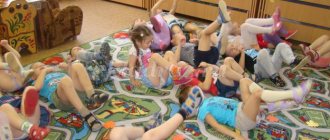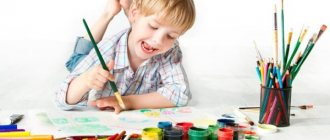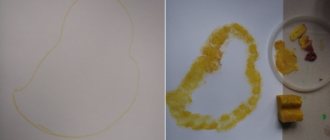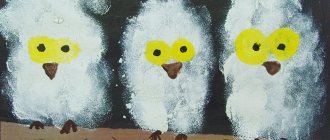Drawing with children of the senior group on the theme “My Native Street”
Teacher Filina S.D.
Drawing with children
of the senior group
on the theme “My Native Street”
Learn to depict in a drawing various houses and buildings located on one side of the street.
Strengthen technical skills and abilities.
Exercise your ability to independently choose means of expression, using traditional and non-traditional methods of painting.
Learn beautifully, select (combine) a color palette when painting.
Learn to place the image over the entire surface of the sheet, determining the location of individual objects
Develop creative abilities.
Cultivate love for your native land.
A4 sheets of drawing paper.
Wax crayons or markers
Preview:
MBDOU "Kindergarten No. 45
Topic: “Streets of our city”
senior group Filicheva Lyubov
Goal: to encourage children to develop a sense of composition when creating a simple urban landscape.
- to help consolidate children’s ideas about architecture and the profession of an architect;
- practice creating a simple composition on the theme of a modern city street, harmoniously placing the drawing on the plane of the sheet.
- ensure the formation of the ability to establish a relationship between the appearance and purpose of a structure, to find the distinctive features of different buildings: number of storeys, color, material, shape;
-encourage you to think through the design of the drawing before starting before execution.
-practice in obtaining intense, bright color when painting small details and light tone when painting houses and the sky.
-ensure the development of creative imagination and activity.
-promote the development of love for one’s hometown.
Materials: album sheets, pictures depicting various buildings, photo illustrations, city landscapes, simple, colored pencils.
-Series of observations “Streets of our city”:
Observation 1. Examination of buildings, their purpose.
Observation 2. What are buildings made of?
Observation 3. Architectural elements of buildings (windows, balconies, loggias, columns).
-Conversation about the architect, architecture.
-Looking at illustrations, photographs, postcards depicting buildings of different architecture.
-Drawing of various houses.
-Reading fiction: S. Baruzdin “Who built this house”, V. Mayakovsky “Who should I be?”, A. Pushkin “The Tale of the Fisherman and the Fish”, Russian folk tale “The Winter of Animals”.
Preparation for OD: carry out wet cleaning in the group, ventilate the room, prepare the material by those on duty, conduct a sedentary game before the lesson. Photos of the city of Trans-Volga region are hung on the board.
Our city is across the river,
And our city is called Zavolzhye.
There is one on the Volga
Where we can live together in harmony.
-Guys, how beautiful our city of Trans-Volga region is! There are many streets in our city. What streets do you know?
Children: Pushkin, Pirogov, Herzen, Lermontov, etc.
Educator: And also Mira Avenue, the spacious V.I. Lenin.
What buildings have you seen on the streets of our city?
Children: Residential buildings, schools, kindergarten, cinema.
Educator: That's right, guys! The builders built many buildings for the Volga residents, but first they had to be designed, the streets had to be thought out.
— What is the name of the science of designing (inventing) buildings?
Q: And the person who designs buildings?
Educator: Guys, let's organize an exhibition of drawings of our city. How can we organize it?
Children: Let's draw pictures about our city.
-I suggest you draw one of the city streets, but which one you decide for yourself.
Educator: Builders try to make houses strong, beautiful, and to serve people for a long time.
— All buildings are different: in some they live, in others they study, in others they trade, in others they relax. Each building corresponds to its purpose.
Therefore, all houses differ in appearance from each other.
— How do residential buildings differ from each other?
Children: Height. There are one-story and multi-story houses.
Educator: What can houses be built from?
D: from logs, bricks, panels.
Guys, please note that residential buildings have windows. How are they located?
Children: In rows, one under the other.
Educator: Are they different in size or the same?
Residential buildings also have comfortable balconies.
Educator: Guys, on the streets of our city, in addition to houses, there are other buildings. Which?
Children: Kindergarten, schools, shop.
Educator: How is the school building different from others?
Children: Wide entrance to the school, large windows, no balconies.
Educator: Guys, we looked at different buildings. I suggest you do a very interesting job today - make an album of drawings on the theme: “Streets of our city.”
I have already prepared the cover.
How are the houses located relative to the street?
Children: The houses are located along the street.
Educator: There is not one building on the street, but several. They are different in size and shape. One building may partially obscure another.
Draw the building, stepping back from the bottom edge of the sheet.
What can you depict between the buildings?
Children: Trees, bushes, benches, lanterns, flower beds.
Educator: What color pencils will we use when painting buildings?
Children: Light, bright.
Educator: And when drawing details?
Educator: And now, guys, you, like the architects, first think about what buildings will be on your street, how and where you will place them on a piece of paper.
Educator: Who wants to talk about their drawing?
Child: I will draw Pushkin Street.
Educator: What street will you draw, Alena? What buildings will be on your street?
Alena: Residential, multi-storey buildings, school, store.
Educator: Guys, first make a light sketch with a simple pencil, and then paint over it.
If you understand, then you can start drawing.
On the topic: methodological developments, presentations and notes
Summary of the integrated lesson “Streets of the native city”. Secondary group. Educational area: cognition. Integration of educational areas: “communication”, “artistic creativity”, “socialization.
Studying traffic rules with children of the middle group.
Topic: “Safety on the street” educational area: Cognition Integration of educational areas: “Cognition”, “Physical development”, “Social and communicative development”, “Speech development.
Summary of direct educational activities on traffic rules in the middle group “Streets of our city.” Goal: Formation of the basis for safe behavior on the street in children of middle preschool age. Objective.
This summary will help you consolidate children’s knowledge about traffic lights, road signs, the purpose of special-purpose vehicles, develop thinking, memory, and the ability to navigate the environment.
Development of curiosity and cognitive interest of preschoolers in the process of forming knowledge about their city. street.
Source
Preview:
GCD Drawing “My Street”
Author: Puchkovskaya Olesya Vladimirovna, teacher, secondary school No. 18 (preschool level), Achinsk
Main educational area: “Artistic and aesthetic development”
Preliminary work: field trip through the city streets, conversations about the city, reading fiction, drawing rectangular and square objects.
Equipment: Luntik toy, portrait of S. M. Kirov, photographs of city streets
Children are located at work places.
The teacher brings in Luntik's toy.
Luntik: Hello. Where did I end up? And who are you? (children's answers)
Luntik: I am Luntik. I fell from the moon. Where did I end up?
Educator: Hello Luntik. We'll tell you everything.
Guys, what is the name of our city? What about our school?
What street is it on? Yes, that's right, on Kirov Street.
Luntik: What an interesting name, and why is the street called that?
Educator: Our street is named after the famous person Sergei Mironovich Kirov (showing a portrait). He was a very smart and strong-willed man, and he became famous for doing a lot of good and useful things for our country, Russia.
Luntik: Oh, how interesting. Is your street beautiful? Tell us about her? (children's stories)
Educator: Well done children. Look Luntik, the children brought photographs with them, let's look and find familiar places. (I post the photo on the board).
Let's go Luntik with the guys for a walk along our street.
Relaxation exercise “Walk”
-Walking along a narrow path
-Walking on toes
-Walking on heels
- Swinging on a swing
Luntik: It was a good walk. You have a big, beautiful street, and how many houses... Why does a person need a house? (children's answers).
Educator: Smart girls. Guys, we all have houses where you live with your beloved family. Who remembers their home address? (children's answers)
Luntik: Why do people need an address? (children's answers)
Luntik: I would like to visit the children.
Educator: I think, Luntik, the guys will be very glad to see you as a guest. In the meantime, play with us.
Finger game “Building a house”
I knock with a hammer, I knock
I'll hammer a hundred nails,
We will build a house, a house,
We will live together in it.
Luntik: Guys, they told us on the moon that you have a lot of animals and birds on your planet. Which animal has which house?
Half of the children are given cards with pictures of animals and birds, and the other half are given houses. Everyone needs to find a mate.
Educator: Well done guys, played well.
Listen to B. Serikbaev’s poem “Home”
I will draw a multi-storey house. Of course, it will be a little papery. Of course, it will not be very brick, but it will be white-walled, but it will be nice. Surely no one will ever drive a puppy away from this house.
Lesson summary “My Street” (middle group)
Elena Chaus
Lesson summary “My Street” (middle group)
Goal: to cultivate in children a love and a sense of pride for their street , their hometown.
• consolidate children's knowledge of the concept of “ street ”
, knowledge of one’s address and the address of the kindergarten, the ability to talk about
the street on which the child lives (NGO “Social and Communicative Development”
, NGO
“Cognitive Development”
, NGO
“Speech Development”
);
• continue to introduce your hometown and its attractions (NGO “Social and Communicative Development”
, NGO
“Cognitive Development”
, NGO
“Speech Development”
, NGO
“Artistic and Aesthetic Development”
);
• activate vocabulary, cognitive interest (NGO “Speech Development”
, NGO
“Cognitive Development”
);
• attract children’s attention to this topic with the help of modern computer technologies (NGO “Cognitive Development”
);
• develop speech, observation, attention, memory, thinking, perception (NGO “Speech Development”
, NGO
“Social and Communicative Development”
, NGO
“Cognitive Development”
);
• develop gross motor skills (NGO “Physical Development”
);
• cultivate love for one’s hometown, street , home, the desire to see them beautiful and clean (NGO “Social and Communicative Development”
, NGO
"Artistic and Aesthetic Development"
).
Preliminary work: conversations about home address, visiting a store, mail, the difference between school and kindergarten; educational games “Find two identical houses”
,
“Where is your home”
, “What is extra
(school supplies)
”,
“Who lives where”
;
role-playing games “Drivers”
,
“Shop”
,
“Kindergarten”
,
“Mail”
;
reading poems by S. Drozhzhin “
Walking the Street ” , S. Marshak
“Mail”
;
guessing riddles about transport; drawing your street (together with parents)
.











